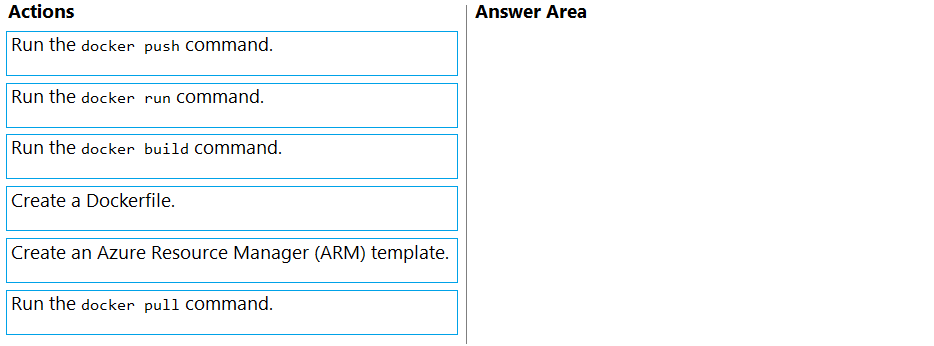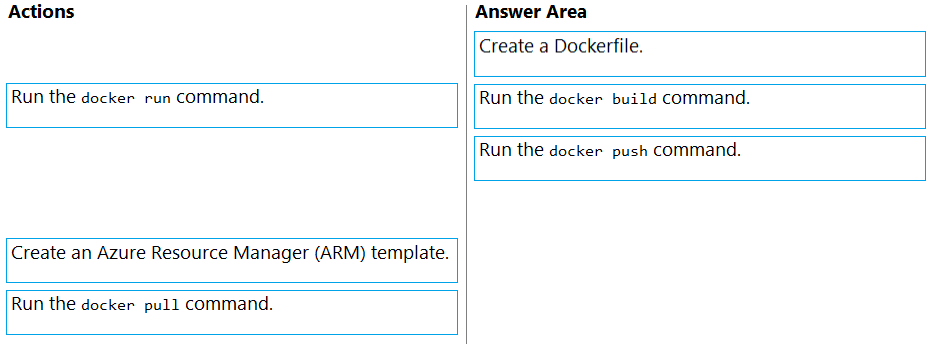DRAG DROP -
You have a server named Server1 that runs Windows Server and has the Web Server (IIS) server role installed. Server1 hosts an ASP.NET Core web app named
WebApp1 and the app's source files.
You install Docker on Server1.
You need to ensure that you can deploy WebApp1 to an Azure App Service web app from the Azure Container Registry.
Which three actions should you perform in sequence? To answer, move the appropriate actions from the list of actions to the answer area and arrange them in the correct order.
Select and Place:
Answer:

Step 1: Create a Dockerfile. This file contains instructions for the build process.
Step 2: Run the docker build command to create a container image.
Step 3: Run the docker push command to upload the image to Azure Container Registry.
You have two servers that run Windows Server as shown in the following table.
You need to copy the contents of volume E from Server1 to Server2. The solution must meet the following requirements:
✑ Ensure that files in-use are copied.
✑ Minimize administrative effort.
What should you use?
Answer:
A
You have an Azure virtual machine named VM1 that has the Web Server (IIS) server role installed. VM1 hosts a critical line-of-business (LOB) application.
After the security team at your company deploys a new security baseline to VM1, users begin reporting that the application is unresponsive.
You suspect that the security baseline has caused networking issues.
You need to perform a network trace on VM1.
What should you do?
Answer:
D
Reference:
https://docs.microsoft.com/en-us/troubleshoot/azure/virtual-machines/performance-diagnostics
You have an Azure virtual machine named VM1. Crash dumps for a process named Process1 are enabled for VM1.
When process1.exe on VM1 crashes, a technician must access the memory dump files on the virtual machine. The technician must be prevented from accessing the virtual machine.
To what should you provide the technician access?
Answer:
C
Reference:
https://docs.microsoft.com/en-us/azure/azure-monitor/agents/diagnostics-extension-overview
You have a server named Server1 that runs the Remote Desktop Session Host role service. Server1 has five custom applications installed.
Users who sign in to Server1 report that the server is slow. Task Manager shows that the average CPU usage on Server1 is above 90 percent. You suspect that a custom application on Server1 is consuming excessive processor capacity.
You plan to create a Data Collector Set in Performance Monitor to gather performance statistics from Server1.
You need to view the resources used by each of the five applications.
Which object should you add to the Data Collector Set?
Answer:
C
You plan to deploy the Azure Monitor agent to 100 on-premises servers that run Windows Server.
Which parameters should you provide when you install the agent?
Answer:
D
Reference:
https://docs.microsoft.com/en-us/windows-server/storage/storage-spaces/configure-azure-monitor
You need to use a comma-separated value (CSV) file to import server inventory to Azure Migrate.
Which fields are mandatory for each entry in the CSV file?
Answer:
B
The following table summarizes the file fields to fill in:
Reference:
https://docs.microsoft.com/en-us/azure/migrate/tutorial-discover-import
Note: This question is part of a series of questions that present the same scenario. Each question in the series contains a unique solution that might meet the stated goals. Some question sets might have more than one correct solution, while others might not have a correct solution.
After you answer a question in this section, you will NOT be able to return to it. As a result, these questions will not appear in the review screen.
Your network contains a single-domain Active Directory Domain Services (AD DS) forest named contoso.com. The functional level of the forest is Windows Server
2012 R2. All domain controllers run Windows Server 2012 R2.
Sysvol replicates by using the File Replication Service (FRS).
You plan to replace the existing domain controllers with new domain controllers that will run Windows Server 2022.
You need to ensure that you can add the first domain controller that runs Windows Server 2022.
Solution: You raise the domain and forest functional levels.
Does this meet the goal?
Answer:
B
Instead migrate sysvol from FRS to Distributed File System (DFS) Replication.
Note: Do I need to change SYSVOL replication from FRS to DFS? If your domain is built based on Windows server 2008 or Windows Server 2008 R2, you are already using DFS for SYSVOL replication. If you originally migrated from Windows server 2003, it's more likely you are still using FRS. In that case, before migration, you need to change the SYSVOL replication method from FRS to DFS.
Reference:
https://www.rebeladmin.com/2021/09/step-by-step-guide-active-directory-migration-from-windows-server-2008-r2-to-windows-server-2022/
HOTSPOT
-
You have the servers shown in the following table. 
You plan to migrate file shares from Server1 to Server2.
You need to deploy the Storage Migration Service and the Storage Migration Service extension.
On which server should you install each component? To answer, select the appropriate options in the answer area.
NOTE: Each correct selection is worth one point.
Answer:

You have an on-premises network and an Azure virtual network.
You establish a Site-to-Site VPN connection from the on-premises network to the Azure virtual network, but the connection frequently disconnects.
You need to debug the IPsec tunnel from Azure.
Which Azure VPN Gateway diagnostic log should you review?
Answer:
D
Reference:
https://docs.microsoft.com/en-us/azure/vpn-gateway/troubleshoot-vpn-with-azure-diagnostics